So. I decided to give the cold cap one try. My hair was now short. But my brain was scrambled.
The issue is timing. It’s all completely overwhelming the day you start chemo. You adjust to new sounds, smells, feelings - the stuff they’re going to pump into you, the dire warnings of side effects, the whole idea of being a fragile flower that’s going to need a lot of monitoring during treatment, plus fragments remembered from tragic scenes from weepy movies and doom-laden documentaries.
Here’s my video guide to cold-capping if you want to see how crazy I look during treatment (and pick up some tips/understand the science bit). To read about what it felt like first time, keep scrolling!
In an ideal world, first-timers would be able to skip scalp cooling during chemo session 1, to get your head round the rest of it.
But the second session is too late. Once that chemo gets to your follicles, they’re toast.
Which meant that as I walked into the unit, as well as fearing life-threatening complications, I was also scared of the cold.
I had already had the chance to look at the ‘suite’1 where I was having chemo before The Big Day - I really recommend this if you can, so it’s less of a shock. But I can’t say I took much notice of the bit of kit in the corner.
Not Jeremy Paxman - but definitely a strong presence
The Paxman machine looks like a medium-sized air conditioning unit. It has a touch screen, and a covered sleeve that I think resembles an elephant’s trunk, connected to the twin helmets of doom. Kidding. SORT OF.
And in between the multiple checks of BP, your name, date of birth, any allergies etc etc, there’s the salon experience. It’s important your scalp is chilled well before the chemo starts, generally at least 30-45 minutes head. NB: in the US, patients usually fit the cap themselves, but in the UK, nurses are trained in how to do it:
First they wet your hair with water, to increase ‘cold conductivity.’ Brrrr.
Next, they add cool, sulphate-free conditioner to the damp strands. This means that when your hair freezes solid, it doesn’t stick to the cap when it needs to come off.
Next, on goes the inner ‘cap’ which is what you’d get if you took a judge’s wig and filled it with bright blue refrigerant. This sits snugly on your scalp - there are three sizes, I was a medium - and looks ridiculous but feels fine. You can also use cotton wool or an Alice band over your ears and forehead - any skin, basically, where your hair isn’t in the way.
I’d already read that some patients take a paracetamol 30 minutes before the process starts so I did that.
Crash test dummy style
And now it gets more intense, because this is when the crash helmet goes over the top. It’s not rigid, but made of a thicker version of wet-suit material. It also has bungee cords… and those are used, along with nursing brute force, to make sure the inner cap is making contact with as much of the scalp as possible. If you ever went back-packing, and overpacked, remember how you’d push and pull until the sleeping bag went in? It’s a bit like that.
Except with a chin strap.
The pressure from the double helmet was intense to start but soon it was nothing. Maybe this was going to be ok…
‘Um, we haven’t switched the machine on yet.’
Now they did.
The cold kicks in surprisingly quickly. You hear crackling as the inner cap fills with coolant. It is intense. Not quite as cold as sticking your head into a frozen lake, but not far off.
And yet… for me, it was not unbearable. I would have liked to take it off, but I didn’t have a violent urge to be free. I did box breathing, tried to think of sunny days. I had also postponed my first coffee of the morning for after the thing was in place, as a distraction and a reward. A heated blanket around my body meant I wasn’t shivery or turning blue.
If you can handle ten minutes, you can handle the whole thing. That’s what I was told by those in the know and - they were right.
To my astonishment, despite being officially nesh2 and rubbish in cold weather, I was cooling and it was ok. Not exactly a spa treatment. But totally doable.
After it’s over - Frosty the Snowgirl
You have to keep it on for at least 60-90 minutes after treatment (depending on the chemo used) before they lift off the outer cap, wait a while for your head to expand again (may have made that up) and then remove the blue inner.
And this is when it felt worthwhile - because there were actual icicles in my hair and I felt like the cancer warrior version of Wim Hof.
Me:
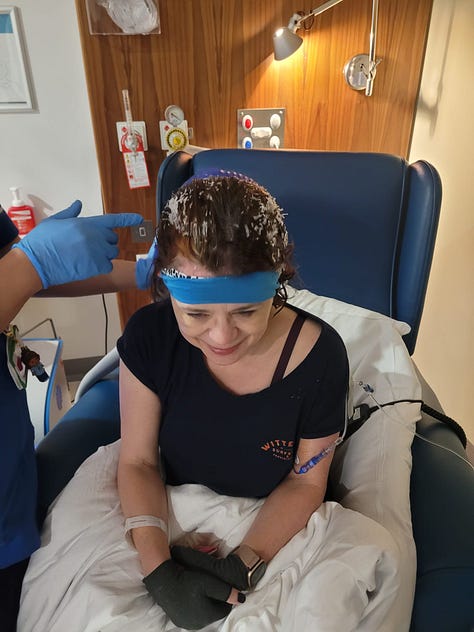
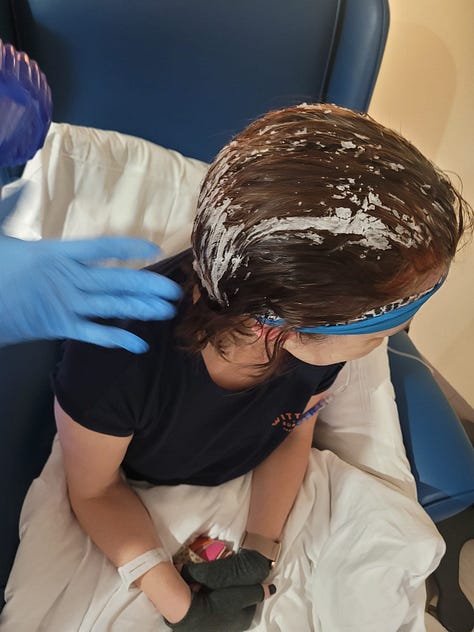
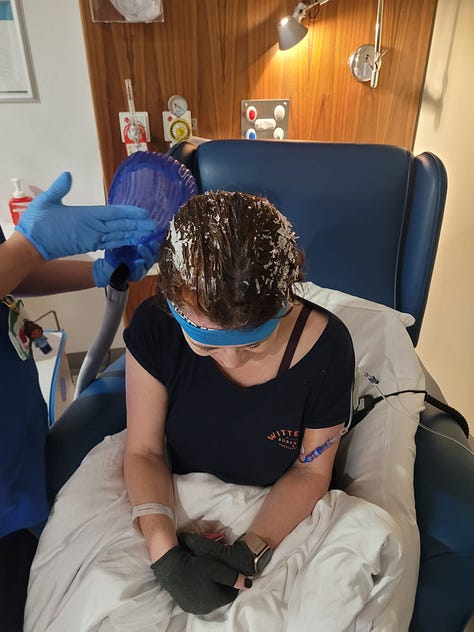
Wim:
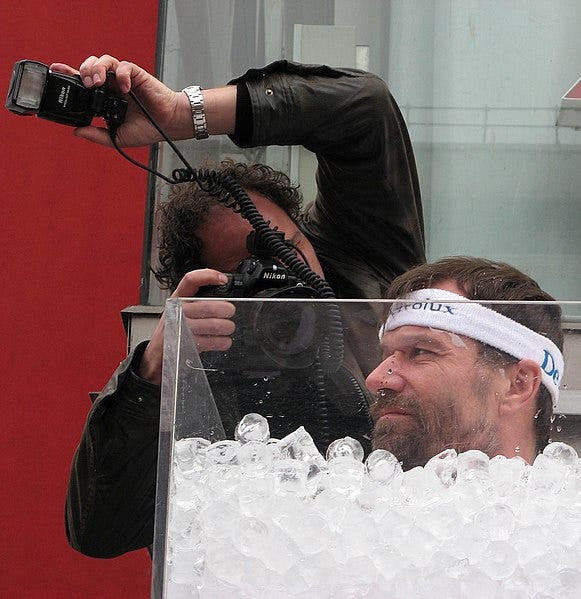
Public service announcement: the brain doesn’t freeze!
It’s very important to know that the cooling doesn’t aim to reduce your scalp, or brain, to zero degrees. Because that would be barmy. Apparently they’re aiming for your scalp to reach a balmy (see what I did there?) 18-22 degrees. It doesn’t feel quite like that.
Why I think cold capping is worth a try:
The lesson here, I think, is if you’re ever in this situation - and I truly hope you won’t be - you might as well give it a shot.
I can really see that if you’re a migraine sufferer, this would be torture. If you can’t stand it, that’s not a failure in any way.
And even if you can tolerate it, there are no guarantees - as I write this, the die is cast. I’m 18 days since my first chemo, and it’s now that hair loss usually starts. Hair on my body is already checking out…
So I’ll find out very soon if scalp cooling has worked or not. There’s a calculator on the Paxman website giving the odds and I have roughly a 50% chance of keeping up to 50-70% of my hair.
Whenever I wake up in the morning, I check my pillow for tufts. And even if it works for this cocktail of chemo, I switch in March to one that is statistically more likely to cause hair loss.
But there is research suggesting that even if I do lose all my hair, cooling can still help improve regrowth once chemo stops.
I also felt really moved the story behind Paxman - they’re a British company, set up when Sue Paxman was diagnosed with breast cancer. She tried an early version of cooling but it failed, she lost her hair during treatment and found it very traumatic. So her husband Glenn tried to find a better solution… and now the system is being used worldwide.
If you’ve made it this far, I hope this all makes more sense now. Do share with anyone who might find it useful.
And as a thank-you, I’m wishing you great hair days forever more.
Yeah, alas, we’re not talking hot tub and beach views here. But often they have a loo because they pump you full of SO MUCH LIQUID.
A word from my Northern English/Scottish heritage, meaning ‘wimpy’ but specifically when it comes to the cold.

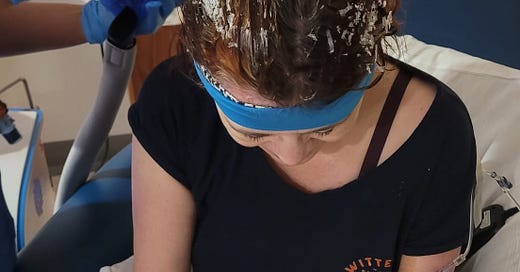



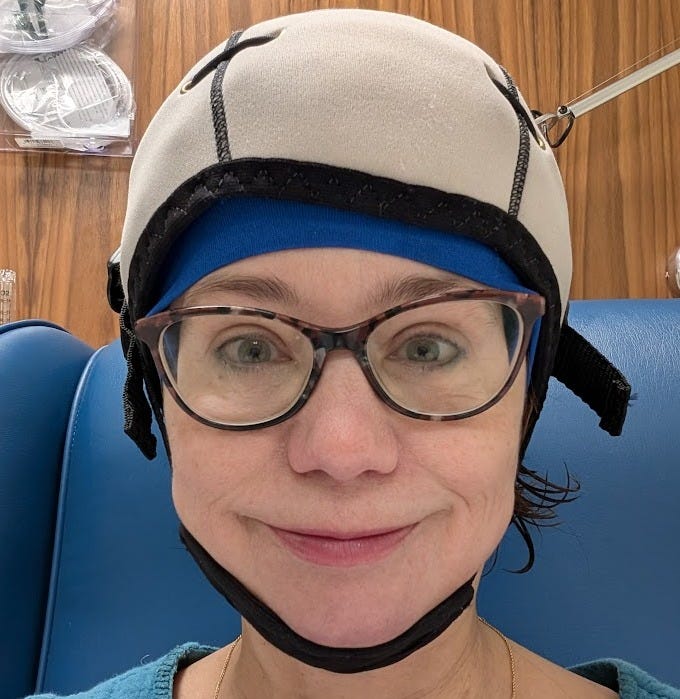
It's emotional watching you show us a small part of the experience you're going through, with all your curiosity and vulnerability. Wishing you success with keeping your lovely locks and that the treatment isn't too harsh. It is cool (oh dear) that our health system cares about these things - your nursing team seems lovely.
Well done, Kate! You did brilliantly - or should that be brrrrrrilliantly! X